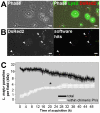Fusion between Leishmania amazonensis and Leishmania major parasitophorous vacuoles: live imaging of coinfected macrophages
- PMID: 21151877
- PMCID: PMC2998430
- DOI: 10.1371/journal.pntd.0000905
Fusion between Leishmania amazonensis and Leishmania major parasitophorous vacuoles: live imaging of coinfected macrophages
Abstract
Protozoan parasites of the genus Leishmania alternate between flagellated, elongated extracellular promastigotes found in insect vectors, and round-shaped amastigotes enclosed in phagolysosome-like Parasitophorous Vacuoles (PVs) of infected mammalian host cells. Leishmania amazonensis amastigotes occupy large PVs which may contain many parasites; in contrast, single amastigotes of Leishmania major lodge in small, tight PVs, which undergo fission as parasites divide. To determine if PVs of these Leishmania species can fuse with each other, mouse macrophages in culture were infected with non-fluorescent L. amazonensis amastigotes and, 48 h later, superinfected with fluorescent L. major amastigotes or promastigotes. Fusion was investigated by time-lapse image acquisition of living cells and inferred from the colocalization of parasites of the two species in the same PVs. Survival, multiplication and differentiation of parasites that did or did not share the same vacuoles were also investigated. Fusion of PVs containing L. amazonensis and L. major amastigotes was not found. However, PVs containing L. major promastigotes did fuse with pre-established L. amazonensis PVs. In these chimeric vacuoles, L. major promastigotes remained motile and multiplied, but did not differentiate into amastigotes. In contrast, in doubly infected cells, within their own, unfused PVs metacyclic-enriched L. major promastigotes, but not log phase promastigotes--which were destroyed--differentiated into proliferating amastigotes. The results indicate that PVs, presumably customized by L. major amastigotes or promastigotes, differ in their ability to fuse with L. amazonensis PVs. Additionally, a species-specific PV was required for L. major destruction or differentiation--a requirement for which mechanisms remain unknown. The observations reported in this paper should be useful in further studies of the interactions between PVs to different species of Leishmania parasites, and of the mechanisms involved in the recognition and fusion of PVs.
Conflict of interest statement
The authors have declared that no competing interests exist.
Figures





Similar articles
-
The diverse and dynamic nature of Leishmania parasitophorous vacuoles studied by multidimensional imaging.PLoS Negl Trop Dis. 2012;6(2):e1518. doi: 10.1371/journal.pntd.0001518. Epub 2012 Feb 14. PLoS Negl Trop Dis. 2012. PMID: 22348167 Free PMC article.
-
Biogenesis of Leishmania-harbouring parasitophorous vacuoles following phagocytosis of the metacyclic promastigote or amastigote stages of the parasites.J Cell Sci. 2002 Jun 1;115(Pt 11):2303-16. doi: 10.1242/jcs.115.11.2303. J Cell Sci. 2002. PMID: 12006615
-
H-2M molecules, like MHC class II molecules, are targeted to parasitophorous vacuoles of Leishmania-infected macrophages and internalized by amastigotes of L. amazonensis and L. mexicana.J Cell Sci. 1999 Aug;112 ( Pt 15):2559-70. doi: 10.1242/jcs.112.15.2559. J Cell Sci. 1999. PMID: 10393812
-
Life in vacuoles--nutrient acquisition by Leishmania amastigotes.Int J Parasitol. 2001 Oct;31(12):1311-20. doi: 10.1016/s0020-7519(01)00259-4. Int J Parasitol. 2001. PMID: 11566299 Review.
-
The biogenesis and properties of the parasitophorous vacuoles that harbour Leishmania in murine macrophages.Trends Microbiol. 1998 Oct;6(10):392-401. doi: 10.1016/s0966-842x(98)01324-9. Trends Microbiol. 1998. PMID: 9807783 Review.
Cited by
-
The diverse and dynamic nature of Leishmania parasitophorous vacuoles studied by multidimensional imaging.PLoS Negl Trop Dis. 2012;6(2):e1518. doi: 10.1371/journal.pntd.0001518. Epub 2012 Feb 14. PLoS Negl Trop Dis. 2012. PMID: 22348167 Free PMC article.
-
Host Organelle Hijackers: a similar modus operandi for Toxoplasma gondii and Chlamydia trachomatis: co-infection model as a tool to investigate pathogenesis.Pathog Dis. 2013 Nov;69(2):72-86. doi: 10.1111/2049-632X.12057. Epub 2013 Jul 22. Pathog Dis. 2013. PMID: 23821471 Free PMC article. Review.
-
ATP6V0d2 controls Leishmania parasitophorous vacuole biogenesis via cholesterol homeostasis.PLoS Pathog. 2019 Jun 14;15(6):e1007834. doi: 10.1371/journal.ppat.1007834. eCollection 2019 Jun. PLoS Pathog. 2019. PMID: 31199856 Free PMC article.
-
Attenuated Leishmania induce pro-inflammatory mediators and influence leishmanicidal activity by p38 MAPK dependent phagosome maturation in Leishmania donovani co-infected macrophages.Sci Rep. 2016 Mar 1;6:22335. doi: 10.1038/srep22335. Sci Rep. 2016. PMID: 26928472 Free PMC article.
-
Increased survival and proliferation of the epidemic strain Mycobacterium abscessus subsp. massiliense CRM0019 in alveolar epithelial cells.BMC Microbiol. 2017 Sep 13;17(1):195. doi: 10.1186/s12866-017-1102-7. BMC Microbiol. 2017. PMID: 28903728 Free PMC article.
References
-
- Rabinovitch M, Veras PS. Cohabitation of Leishmania amazonensis and Coxiella burnetii. Trends Microbiol. 1996;4:158–161. - PubMed
-
- de Chastellier C, Thibon M, Rabinovitch M. Construction of chimeric phagosomes that shelter Mycobacterium avium and Coxiella burnetii (phase II) in doubly infected mouse macrophages: an ultrastructural study. Eur J Cell Biol. 1999;78:580–592. - PubMed
-
- Andreoli WK, Taniwaki NN, Mortara RA. Survival of Trypanosoma cruzi metacyclic trypomastigotes within Coxiella burnetii vacuoles: differentiation and replication within an acidic milieu. Microbes Infect. 2006;8:172–182. - PubMed
Publication types
MeSH terms
LinkOut - more resources
Full Text Sources
Research Materials

